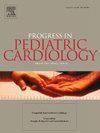Desmoplakin related cardiomyopathy with contrasting desmoplakin dermatologic changes: A case series and review of the literature
IF 0.8
Q4 PEDIATRICS
引用次数: 0
Abstract
Introduction
Desmoplakin (DSP) genetic variants cause various cardio-cutaneous phenotypes. DSP related cardiomyopathy (DSP-CM) is a cause of arrhythmogenic cardiomyopathy (ACM). Patient presentation is highly variable, and dermatologic manifestations are often the first sign of impending cardiac dysfunction. A subset DSP-CM patients require advanced cardiac therapies (ACT) such as heart transplantation (HTx).
Case description
Patient 1 is a male neonate who presented at birth with tense bullae and erosions scattered on the body. Genetic panel disclosed two DSP variants. He was diagnosed with DSP-related skin fragility. At age 2.5 years, DSP-CM developed, leading to aborted cardiac arrest and HTx at age 4.
Patient 2 is a 15-year-old male who presented with new onset dilated cardiomyopathy and wooly hair, hypodontia, and onychodystrophy. Genetic testing revealed a DSP variant, which was diagnostic for DSP-CM with woolly hair, keratoderma, and tooth agenesis. He underwent HTx 1 month after presentation.
Discussion
DSP variants cause a distinct form of ACM. Left dominant cardiomyopathy and systolic dysfunction were the primary manifestations in our patients. Pediatric DSP-CM cases are sparse in the literature. We demonstrate that patients with DSP-CM can successfully undergo HTx with special attention to treatment of their dermatologic disease.
Desmoplakin相关性心肌病与Desmoplakin皮肤变化的对比:一个病例系列和文献回顾
desmoplakin (DSP)基因变异引起各种心脏皮肤表型。DSP相关性心肌病(DSP- cm)是致心律失常性心肌病(ACM)的一种病因。患者的表现是高度可变的,皮肤症状往往是心功能障碍的第一个迹象。一部分DSP-CM患者需要高级心脏治疗(ACT),如心脏移植(HTx)。病例描述:患者1是一名男婴,出生时出现紧张的大泡和分散在身体上的糜烂。遗传小组披露了两个DSP变体。他被诊断患有与dsp相关的皮肤脆弱症。2.5岁时,DSP-CM发展,导致心脏骤停流产和4岁时HTx。患者2为15岁男性,新发扩张性心肌病、毛发绵长、牙下畸形和甲营养不良。基因检测显示一种DSP变异,可诊断为DSP- cm伴毛毛、角化皮病和牙齿发育不全。1个月后接受HTx治疗。dsp变体导致不同形式的ACM。左显性心肌病和收缩功能障碍是本组患者的主要表现。儿科DSP-CM病例在文献中很少。我们证明患有DSP-CM的患者可以成功地接受HTx治疗,并特别注意治疗他们的皮肤病。
本文章由计算机程序翻译,如有差异,请以英文原文为准。
求助全文
约1分钟内获得全文
求助全文
来源期刊

PROGRESS IN PEDIATRIC CARDIOLOGY
PEDIATRICS-
CiteScore
0.90
自引率
11.10%
发文量
69
审稿时长
75 days
期刊介绍:
Progress in Pediatric Cardiology is an international journal of review presenting information and experienced opinion of importance in the understanding and management of cardiovascular diseases in children. Each issue is prepared by one or more Guest Editors and reviews a single subject, allowing for comprehensive presentations of complex, multifaceted or rapidly changing topics of clinical and investigative interest.
 求助内容:
求助内容: 应助结果提醒方式:
应助结果提醒方式:


